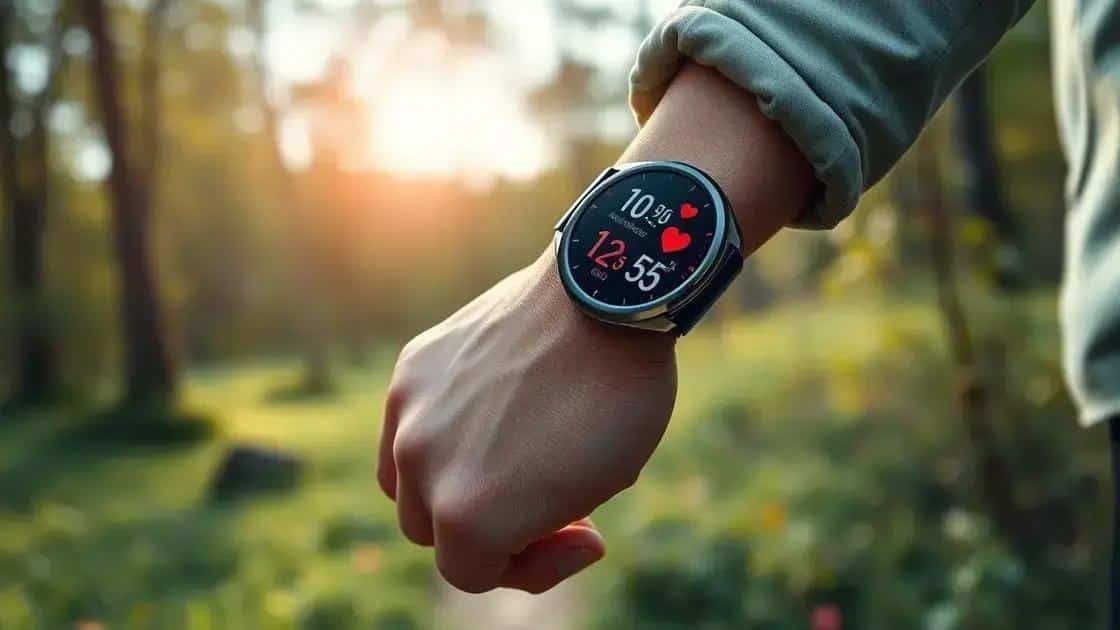Wearable tech innovation insights: what’s next?

Wearable tech innovations are transforming health management by providing real-time monitoring, personalized insights, and health tracking through advanced features like AI integration and smart textiles.
Wearable tech innovation insights are not just buzzwords; they are transforming how we live, work, and connect. Curious about what’s driving this revolution? Let’s dive in!
Understanding wearable tech advancements
Understanding the latest wearable tech advancements helps us grasp how technology evolves to enhance our daily lives. From smartwatches to fitness trackers, wearables have transformed personal health management and daily tasks.
Key Features of Wearable Tech
Modern wearable devices come packed with features that make them indispensable for many users. These include:
- Health monitoring
- Notifications and alerts
- GPS tracking
- Customization options
These innovations offer impressive enhancements that appeal to a broad audience. For example, users can monitor their heart rate, track their sleep patterns, and receive important notifications without needing to check their phones.
Popular Wearable Devices
Various devices have emerged, leading the market with their innovative capabilities. Some of the most popular include:
- Smartwatches by brands like Apple and Samsung
- Fitness trackers from Fitbit and Garmin
- Smart glasses, providing augmented reality experiences
- Health monitors that track vital signs continuously
As technology continues to evolve, these devices will likely incorporate even more features, enhancing their functionality and user experience.
Wearable tech has also paved the way for smart clothing, which integrates sensors directly into fabrics. This innovation offers new ways to monitor health metrics, making fitness tracking more accessible and intuitive.
The impact of wearables on health

The impact of wearables on health is significant, changing how we monitor and manage our well-being. These devices provide real-time data that empowers users to make informed decisions about their health.
Health Monitoring Features
Many wearables come equipped with health monitoring features, allowing individuals to track vital signs easily. Some of the key features include:
- Heart rate monitoring
- Step counting and activity tracking
- Sleep quality analysis
- Caloric expenditure tracking
This data helps users understand their physical activities better, encouraging a more active lifestyle. For instance, knowing how many steps you take each day can motivate you to set and achieve personal fitness goals.
Chronic Condition Management
Wearable devices are proving to be invaluable for those with chronic conditions. For example, individuals with diabetes can use wearables to track their blood sugar levels.
Additionally, wearables can alert users to abnormalities, helping them manage their conditions more effectively. This instant feedback offers peace of mind and encourages proactive health management.
Improving Mental Well-Being
Beyond physical health, wearables also influence mental well-being. Many devices incorporate features for mindfulness and stress management, such as:
- Guided breathing exercises
- Stress level tracking
- Reminders to take breaks
By addressing both physical and mental health needs, wearables contribute to an overall enhanced quality of life.
Key players in wearable technology
Key players in wearable technology are driving innovation and shaping the market landscape. These companies are focused on creating devices that enhance our lifestyles and provide valuable health insights.
Leading Brands in Wearables
Several brands stand out in the wearables market due to their innovative products. Some of the most notable include:
- Apple: Known for its smartwatches that seamlessly integrate with iOS devices.
- Fitbit: Specializes in fitness trackers that help users monitor their health effectively.
- Garmin: Offers advanced fitness wearables catering to athletes and outdoor enthusiasts.
- Samsung: Provides a range of smartwatches that balance style with functionality.
Each of these companies has carved out a unique niche with products that appeal to various consumer needs, from health tracking to lifestyle enhancements.
Emerging Players
In addition to established brands, emerging companies are also making their mark in the wearable tech industry. Some up-and-coming names include:
- Withings: Focused on health-focused wearables with precise biometric measurements.
- Xiaomi: Known for affordable fitness bands that deliver outstanding value.
- Oura: Offers smart rings that track sleep and readiness metrics.
These emerging players often focus on specific markets or unique functionalities, contributing to a broader range of choices for consumers.
Additionally, tech giants like Google are expanding their reach into wearables through acquisitions and partnerships, further reshaping the competitive landscape in this fast-evolving industry. As they integrate AI and advanced analytics into wearables, the potential for innovation grows even more.
Future trends in wearable innovations

Future trends in wearable innovations are set to redefine how we interact with technology and improve our health management. As the wearable tech market grows, new advancements will emerge, focusing on enhanced capabilities and user experience.
Integration of AI and Machine Learning
In the future, wearable devices will increasingly rely on artificial intelligence (AI) and machine learning. By processing vast amounts of health data, these technologies will provide personalized insights.
- Predictive health monitoring can inform users about potential health issues before they arise.
- Adaptive learning will tailor suggestions based on user behavior and performance.
- Real-time analytics will enhance decision-making regarding fitness and wellness.
This personalized approach will help users engage more deeply with their health, making wearables essential tools for proactive management.
Expansion of Smart Textiles
Smart textiles are another exciting trend in wearable innovations. These fabrics integrate sensors and technology into clothing. Imagine a shirt that monitors your heart rate or a pair of socks that track your foot movements.
These innovations open up new possibilities for athletes and everyday users. By providing continuous monitoring without adding bulk, smart textiles will enhance comfort while delivering valuable data.
Emphasis on Data Security and Privacy
As wearables gather more personal data, concerns about data security will continue to grow. Future innovations must prioritize user privacy and protection.
- Encryption methods will secure private information effectively.
- User control over data sharing will become a standard feature.
- Transparency regarding data collection practices will build consumer trust.
The commitment to safeguarding user data will shape the evolution of wearables, ensuring they remain user-friendly and reliable.
FAQ – Frequently Asked Questions about Wearable Technology Innovations
What are the main benefits of wearable technology for health?
Wearable technology helps users monitor vital signs, track fitness activities, and manage chronic conditions, enhancing personal health management.
How is artificial intelligence used in wearables?
AI in wearables provides personalized health insights, predictive analytics, and real-time data processing to improve user experience.
What trends should we expect in future wearable innovations?
Future trends include smart textiles, further AI integration, enhanced data privacy, and improved user experiences.
Which companies are leading the wearable tech market?
Key players include Apple, Fitbit, Garmin, and emerging brands like Withings and Xiaomi, all contributing to innovation in wearables.





